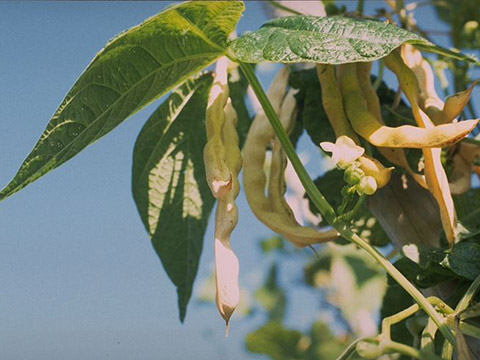Botanical name
Phaseolus vulgaris L.
Family
Fabaceae
Common name
Common bean, Kidney bean, French bean, Haricot bean, Runner bean
Information about the plant
The green bean was originally native to South America, from northern Argentina, Bolivia, and Peru up to Mexico. It has been cultivated in Europe since the 17th century. Today, it is cultivated in all countries.
The genus name comes from the Greek ‘phaseolos’ (= boat), referring to the curved shape of the pod, which resembles an elongated boat on the water. The species epithet vulgaris is Latin and means ‘common’. The German word ‘Bohne’ (bean) derives from the Indo-European sound ‘bha’, which transitioned from describing the inflated cheeks to describing the swollen pod. Originally, however, it referred to the thick broad bean, although the term was later also used for the slimmer common bean.
The green bean is a low, bushy, or twining annual plant that grows up to 4 meters tall. Its stem is branched; the leaves are trifoliate, with the two lower leaves being stalkless and the upper leaf having a long stalk. The flowers are also long-stalked and arranged in clusters of 2 to 6 in the axils of bracts, forming inflorescences. The white, pale pink, or purple flowers consist of a flag with a very short claw and a round, strongly recurved plate. The two wings have longer claws with a strongly curved plate, joined to the keel at the base. The legumes are 10 to 20 cm long and 1 to 2 cm wide, sometimes even curved in a crenate shape, with nodular swellings around the seeds (2 to 8).
Medicinally used parts of plants (herbal drug)
The green bean pods (Phaseoli pericarpium - Phaseoli fructus sine semine) are used after the seeds have been removed, cut, and dried.
The herbal substance comes from cultivations in various European countries (including Bulgaria, Hungary, the former USSR, and former Yugoslavia).
Constituents of the herbal drug
Green bean pods contain sugar, amino acids, hemicelluloses, minerals, and other ubiquitous substances.
Quality of the drug
The quality of the green bean pods (Phaseoli pericarpium) is specified in the German Drug Codex (DAC).
Medical applications
Recognised medical use
The HMPC has classified the green bean pods as a traditional herbal medicinal product (see ‘Traditional use’).
ESCOP: The green bean pods have not been evaluated.
Green bean pods are considered in folk medicine to lower blood sugar levels. However, there is no scientific evidence to support this claim, and therefore, this application could/cannot be upheld. The use of green bean pods to lower blood sugar in diabetics is therefore not recommended
Traditional use
Green bean pods have been classified by the HMPC as a traditional herbal medicinal product (Article 16a of Directive 2001/83/EC). Based upon long-standing use, green bean pods can be used to increase the amount of urine to achieve flushing of the urinary tract as an adjuvant in minor urinary tract complaints.
Herbal drug preparations in finished dosage forms
- Chopped green bean pods for tea preparation
Dosage
Finished medicinal product: see patient information leaflet.
Tea: Drink a cup of green bean pods tea 2 to 6 times a day. Daily dose 5 to 15 g drug. A combination with other herbal drugs such as goldenrod, birch leaves. or nettle leaves (bladder and kidney tea, urine tea) is also recommended.
Preparation of a tea
Pour approximately 150 ml boiling water over 2.5 g green bean pods and strain after 10 minutes.
Notes
During flushing therapy, drink sufficient fluids! Flushing therapy with green bean pods should not be used in cases of edema due to impaired heart and kidney function. If fever, urinary retention, cramps during urination, or blood in the urine occur during treatment, medical advice must be sought.
No safety studies are available on the use of green bean pods during pregnancy and lactation. The use in children and adolescents under the age of 18 is not recommended due to a lack of evidence.
Side effects
None known.
Interactions
None known.


